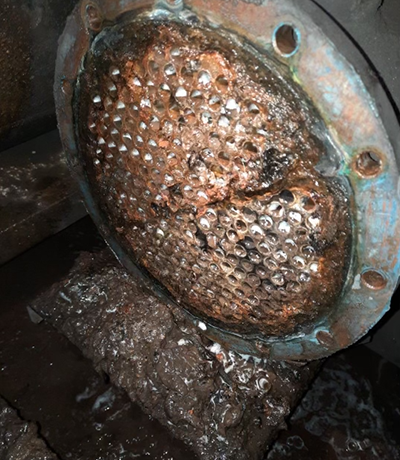
Water-cooled compressors can have an advantage in locations where the ambient conditions are hot — and therefore using air cooled compressors would result in discharge temperatures that exceed the capacity of the air-drying systems. Overloading air dryers could result in free water entering the plant piping system. This would cause contamination of connected machines and tools, and possible quality problems with the plant’s final products.
Water-cooled compressors can be connected to evaporative cooling systems that can pull down the temperature of the cooling water to below the ambient temperatures, preventing overheating during hot summer days. But it is important to ensure the quality of water running through the compressor coolers is good, because otherwise the coolers will clog up, allowing the compressors to overheat.
This is just what happened at the industrial plant subject to the photograph Fig. 1. Very often the lack of proper treatment of the water, and poor blowdown flows, will allow an excess of minerals to remain in the cooling water loop. These minerals will precipitate out onto the cooling tubes leading to blockage.
In the case of the plant in the photograph, the blockage was found to be biological. Improper treatment of the water was allowing organisms to grow within the cooling water loop which plugged up cooling surfaces with a slimy, ugly deposits — leading to overtemperature shutdowns of the compressors.
These coolers were cleaned and the compressors returned to normal operating conditions, discharging temperatures that the refrigerated air dryers could adequately handle. This improved the plant air quality and the reliability of the system because unexpected shutdowns were prevented.
Investigation revealed that the company responsible for the water treatment was not doing their job and was replaced. Be sure to maintain cooling water circuits and clean out heat exchangers as required.
Filed Under: Components Oil Coolers, Compressed Air Technologies, Pneumatic Tips, Technologies